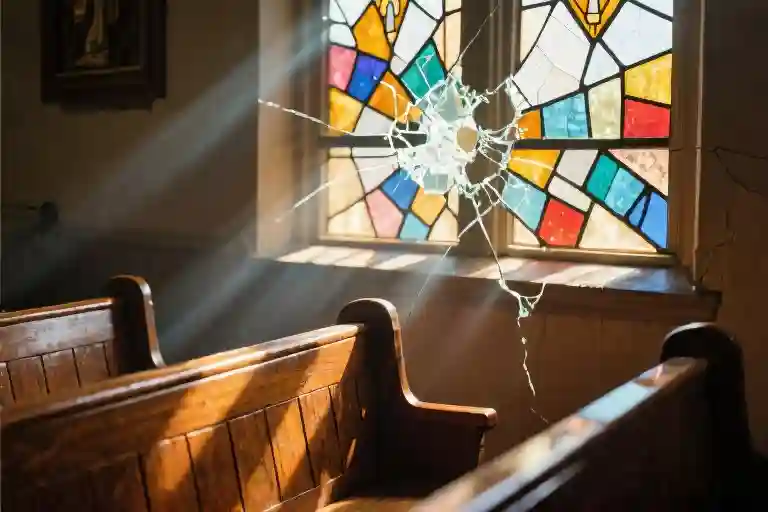The leather-bound Bible felt heavy in my five-year-old hands, its gold-edged pages catching the stained-glass light as the congregation sang ‘Happy Birthday’ off-key. That moment contained everything I then knew of love—the pastor’s hand on my shoulder, my mother’s teary smile, the warmth of belonging. Only decades later would I recognize the metallic aftertaste hidden in that sacramental sweetness, the way devotion and control blended seamlessly like communion wine.
Religious indoctrination rarely announces itself as such. Unlike the dramatic brainwashing scenarios portrayed in films—with their isolation chambers and overt coercion—the gentler varieties weave themselves into the fabric of ordinary life. They smell like potluck casseroles and sound like bedtime prayers. This quiet permeation makes them far more potent than any forceful conversion tactic could ever be.
What transforms spiritual guidance into psychological control isn’t the content of beliefs, but their enforcement mechanisms. When questions get labeled as rebellion when doubt gets treated as disease, when love gets conditional on compliance—that’s when faith mutates into something darker. I remember tracing my finger over the Bible’s embossed cross that birthday morning, unaware that this sacred text would later be weaponized to shame my curiosity about fossils and dinosaurs.
The most effective indoctrination doesn’t feel like imprisonment. It feels like home. It comforts with answers before questions can fully form, rewards conformity with social approval, and—crucially—teaches you to distrust any version of reality that originates outside its boundaries. My childhood church never needed chains; we voluntarily policed each other’s thoughts, mistaking this vigilance for righteousness.
Now I recognize the fingerprints of mind control on what I once called truth: The way certain Bible verses were emphasized while others went unmentioned. The nervous laughter when someone asked about contradictions in scripture. The subtle shaming of university education as ‘worldly.’ These weren’t isolated incidents but part of an intricate architecture of belief maintenance.
Yet for all its sophistication, no indoctrination system is airtight. The human mind has a stubborn tendency toward curiosity, and absolute information control is impossible in our interconnected age. My awakening began with ordinary moments—a biology textbook left open in the library, a friend’s innocent question about why our church had no female leaders, the cognitive dissonance of seeing our ‘humble’ pastor drive a new Mercedes while missionary collections increased.
Perhaps the most insidious aspect of religious conditioning is how it co-opts our best emotions. The same community that taught me compassion also taught me to fear outsiders. The same love that comforted me also kept me obedient. Untangling this knot requires recognizing that the presence of authentic goodness doesn’t negate the simultaneous presence of manipulation—both can be true at once.
That childhood Bible still sits on my shelf, its spine cracked from years of use. I keep it as a reminder that breaking free from indoctrination doesn’t mean rejecting everything you once loved, but learning to see familiar things with new eyes. The first step is simple yet profound: allowing yourself to entertain the possibility that those who taught you what to think might have been wrong.
The Gentle Tyranny of Unseen Cages
The most effective cages don’t rattle. They cradle you in velvet-lined confinement, whispering that the bars are actually birthday ribbons. I know this because I grew up inside one – a religious upbringing so warm and bright that the shadows took decades to notice.
Brainwashing wears many costumes. At its most theatrical, we recognize it immediately: armed guards, barbed wire, sleep deprivation. But the Sunday school variety operates differently. Here, indoctrination smells like crayons and communion wafers, sounds like a children’s choir practicing for the Christmas pageant. The psychological mechanisms remain strikingly similar – emotional bonding, information control, fear conditioning – just wrapped in pastel-colored paper.
Studies suggest nearly 80% of lifelong belief systems solidify before age twelve. Childhood brains are remarkably receptive to authority figures, creating what psychologists call ‘cognitive grooves’ – neural pathways that become default routes for processing information. My third-grade teacher had a phrase for this: ‘Give me a child until he’s seven, and I’ll give you the man.’ At the time, I thought she meant shaping character. Now I understand she was describing the golden window for ideological imprinting.
What makes this soft indoctrination particularly insidious is its dual nature. The same hands that patted my head approvingly for memorizing Bible verses would later slam shut encyclopedias containing evolutionary theory. The voice that tenderly explained Jesus’s love would hiss warnings about ‘outsiders’ who might ‘lead me astray.’ This carrot-and-stick approach creates what sociologists term ‘affective conditioning’ – linking intense emotional experiences (community love, spiritual euphoria) with specific belief systems.
Information filtering operates equally subtly. Our church library conspicuously lacked any books published after 1950, except for those by a handful of approved authors. Internet access came with pre-installed filters blocking ‘secular humanist’ websites. This created what I now recognize as a perfectly engineered echo chamber, though at the time it simply felt like ‘truth.’
The real genius of this system lies in its self-reinforcing nature. Questioning the doctrine didn’t just risk punishment – it threatened to sever those hardwired emotional connections to everyone I loved. When your entire support network exists within the belief system, doubt becomes synonymous with abandonment. This explains why so many remain in ideological cages long after recognizing the bars – the psychological cost of freedom feels prohibitively expensive.
Yet cracks inevitably appear. For me, it began with small dissonances – the pastor’s new luxury car coinciding with increased tithing sermons, the way certain Old Testament stories changed emphasis depending on current church scandals. These weren’t dealbreakers initially, just pebbles in my mental shoe that I kept trying to shake out. But pebbles have a way of accumulating until walking becomes impossible.
What finally made the cage visible wasn’t some dramatic revelation, but rather the slow drip of unanswered questions. Why were we discouraged from visiting other churches? What explained the rotating door of youth group leaders who ‘fell into sin’? Why did biblical interpretations always coincidentally benefit those in power? The system’s fragility became apparent not when I stopped believing, but when I realized how desperately it needed my not-questioning.
The Gilded Cage: A Religious Childhood
The scent of warm communion wafers still lingers in my memory—thin, crisp discs that dissolved into sugary nothingness on my tongue. Every Sunday morning at 9:15 precisely, sunlight would stream through the stained glass, casting colored patterns on the oak pews as we children lined up for this sacred snack. To my seven-year-old self, this ritual tasted like divine approval.
But memory has a way of preserving contrasts. The same wooden confessional booth that smelled faintly of lemon polish also carried the musty odor of damp hymnals and something darker—the metallic tang of fear when Father Donovan’s shadow loomed behind the lattice screen. We were taught this was where God forgave sins, though nobody explained why forgiveness required describing our childish transgressions to a grown man in a darkened box.
The system operated with quiet efficiency. Collection plates polished to a mirror shine passed hand to hand each week, their brass bottoms gleaming under fluorescent lights. I’d watch my mother’s wedding ring clink against the metal as she dropped in crisp bills—’For the new parish hall,’ she’d whisper. Years later, municipal court records would show how those donations built something else entirely: legal defenses for men whose sins far outweighed anything we children could imagine confessing.
Sunday school teachers wielded flannelgraph boards like psychological scalpels, carefully selecting which biblical scenes to display. Noah’s animals marched two by two in colorful felt, but the genocide of Canaanite children never made the cut. We memorized Psalms about green pastures while our workbook margins filled with doodles—unconscious rebellions against lessons that somehow always circled back to obedience.
The violence hid in plain sight. A stained-glass Jonah being swallowed by the whale delighted us during children’s sermons, yet when Mrs. Henderson asked why God would kill a man for steadying the ark (2 Samuel 6:6-7), Pastor Jim quickly redirected to ‘God’s mysterious ways.’ The curriculum included felt-board crucifixion scenes but omitted the sexual violence in Judges 19. Selective storytelling became my normal.
Church camp brought the most potent contradictions. We roasted marshmallows by firelight singing ‘Kumbaya,’ then trembled through hellfire sermons where counselors dramatized eternal torment with flashlight-lit faces. The same hands that braided my hair during crafts later held me underwater during baptismal practice, insisting I stop struggling ‘and trust like Abraham.’ Joy and terror became inseparable twins.
Looking back, the most effective indoctrination wasn’t the overt threats but the loving gestures that made questioning feel like betrayal. When I won the Bible verse memorization contest, Sister Marguerite hugged me so tight I could smell the lavender sachets in her habit. That scent still triggers conflicting impulses—pride in my childhood devotion and anger at how affection was weaponized against curiosity.
The ledger of my childhood holds these competing entries: potluck dinners where casserole dishes scraped bare amid laughter, and hushed meetings where elders decided which teenage pregnancy to conceal. Choir robes starched bright white, and the yellowed paperwork that later revealed decades of hushed transfers. We children absorbed it all as part of God’s inscrutable plan, never realizing the sweetness in our mouths couldn’t mask the corrosion in the system.
Only in adulthood did I begin separating the flavors—recognizing how the wafer’s saccharine taste had been engineered to cover more bitter truths. The realization came slowly, like daylight revealing dust motes in a supposedly spotless sanctuary. What once seemed like divine order now showed its seams: the careful stage management, the strategic omissions, the way love and control shared the same hymnbook.
The Crack Where the Light Gets In
Certain books carry more than words between their covers. The copy of On the Origin of Species I found in my college library had three layers of marginalia—pencil notes from a biology student, angry red underlines from what I suspect was a theology major, and my own trembling annotations in blue ink. This was my first encounter with forbidden knowledge, the kind our youth pastor had warned would ‘make faith shrivel like salted slugs.’
What struck me wasn’t Darwin’s arguments about finch beaks, but the realization that entire realms of thought had been deliberately kept from me. The index cards tucked inside the book (left by some previous reader) listed seventeen local churches that had banned its discussion. My stomach knotted when I recognized my childhood congregation’s letterhead on one. That moment split my consciousness—part of me still hearing the Sunday school teacher’s voice (‘Those who doubt burn twice’), while another part began whispering: If they lied about this being dangerous, what else did they exaggerate?
Then came Sister Mary’s exile. She’d taught me piano using hymnals with her handwritten harmonies in the margins—the kind of small rebellion that went unnoticed until she questioned the bishop’s new building fund. I watched grown adults who’d baked casseroles for her cancer treatment suddenly speak of ‘doctrinal cancer.’ The speed of her erasure haunted me; by winter, the congregation sang her arrangements while pretending she’d never existed. That’s when I understood indoctrination isn’t just about adding beliefs, but surgically removing memories.
But the deepest fracture came from an unexpected source—my atheist roommate casually asking over pizza: ‘Do you actually believe, or do you just remember believing?’ The question hung in the air like incense smoke. I opened my mouth to recite the Apostle’s Creed, but my tongue stuck to the roof of my mouth. All those years of perfect Sunday attendance, yet I couldn’t distinguish between my own convictions and the reflexes of a well-trained mind.
These three moments shared a common thread—not dramatic confrontations, but quiet realizations that the world contained more shadows and light than I’d been shown. The Darwin incident revealed deliberate ignorance. Sister Mary’s disappearance demonstrated social enforcement. My roommate’s question exposed automatic thinking. Together, they formed a triangulation that located my indoctrination with unsettling precision.
What surprises me now isn’t how thoroughly I was shaped, but how fragile that shaping proved when confronted with simple questions. The mind control we imagine involves dark rooms and screaming—the reality is subtler, built on selective information and social reinforcement. Break either element, and the entire structure starts groaning at the seams.
The Mental Toolkit: Five Ways to Recognize and Resist Indoctrination
The moment you start questioning beliefs you’ve held since childhood feels like discovering a hidden door in your childhood home. You always knew every corner of that house—or thought you did—until your fingers brush against unfamiliar grooves in the wallpaper. What frightened me most wasn’t finding the door, but realizing how long I’d walked past it without seeing.
1. Dissecting Absolute Language
Religious and ideological systems often build their foundations with linguistic concrete. Phrases like “always,” “never,” or “the one true way” create mental barriers that discourage examination. I remember how our youth pastor would say “No good Christian would ever question scripture” with such certainty that for years, the possibility of asking why never occurred to me.
The turning point came when I noticed how political leaders used identical phrasing. That linguistic mirror reflected the manipulation I’d accepted as divine truth. Now when I hear absolute claims, I automatically ask: What exists outside this frame? Who benefits from this certainty?
2. Tracing Fear to Its Source
Religious indoctrination often plants its deepest roots through fear—of hell, of abandonment, of losing community. As a child, I had recurring nightmares about the rapture, convinced I’d wake to find my family vanished because I’d doubted too much.
The breakthrough happened when I mapped the timeline: my fear of eternal punishment began exactly one week after the “Hellfire Sunday” sermon series. Seeing that manufactured correlation helped defuse its power. Now I approach fears with forensic curiosity—when did this start? Who taught me to feel this way?
3. Forced Exposure to Contrary Ideas
Our church called it “spiritual protection”—avoiding secular books, liberal news outlets, anyone who might “lead us astray.” This information control created what psychologists call the illusion of explanatory depth—we believed we understood opposing views without ever genuinely encountering them.
I deliberately broke this pattern by reading the most challenging books I could find, from Darwin to Hitchens. The world didn’t end. My faith did, but my humanity expanded. Now I actively seek out thoughtful disagreement—it’s become my litmus test for intellectual honesty.
4. Mapping Relationships vs. Control Networks
Not every community is a cult, but every cult masquerades as community. I started analyzing my relationships through two questions: Do these people encourage my growth beyond their ideology? Would they still care for me if I left?
The answers stung. Many “brothers and sisters” disappeared when I stopped attending. But some surprised me—like Mrs. Henderson, my Sunday school teacher, who still meets me for coffee despite knowing I’ve left the faith. These exceptions revealed what authentic connection looks like.
5. Embracing the Discomfort of Not Knowing
Religious indoctrination sells certainty like a drug. Withdrawal symptoms include existential vertigo—that terrifying free-fall when old answers no longer satisfy but new ones haven’t formed yet. For months I envied my former self’s unshakable convictions.
Gradually I realized: doubt isn’t the opposite of faith; certainty is. Learning to tolerate ambiguity became my most powerful tool. Now when someone claims to have all the answers, I hear the rattle of ideological handcuffs.
These tools didn’t free me overnight. Like any skill, mental self-defense requires practice. Some days I still hear my pastor’s voice warning against “dangerous questions.” But now I recognize that voice for what it is—not divine wisdom, but the echo of someone who was also afraid to look behind the wallpaper.
Navigating the Thorny Path: How to Keep Love Alive After Awakening
The moment you start questioning long-held beliefs feels like stepping onto a fragile bridge between two worlds. One one side, the familiar comfort of shared traditions with family and lifelong friends. On the other, the terrifying freedom of thinking for yourself. This crossing doesn’t have to mean burning bridges – there are ways to maintain connection while honoring your truth.
Scripts for Impossible Conversations
That first dinner after your worldview shifts becomes an emotional minefield. Your mother passes the mashed potatoes like always, but now her casual “We’ll pray for your soul” lands differently. These exchanges don’t need to end in slammed doors if you prepare some gentle navigation tools:
- The Acknowledgment Pivot
When Aunt Martha declares “You’ll find your way back to God,” try:
“I know you say that because you care about me. What I need right now is your trust that I’m being thoughtful about these questions.”
This honors her intention while establishing boundaries. - The Shared Values Reminder
With parents who equate belief with morality:
“Remember how you taught me to care for others? That hasn’t changed. I’m still the person who volunteers at the shelter – just now with different reasons.” - The Time-Out Signal
For escalating debates:
“I love you too much to risk damaging our relationship over this. Can we table this discussion and just enjoy being together today?”
The key lies in separating the person from the doctrine. My father once shouted that Satan had me – until I quietly asked, “Does that really sound like me?” Seeing his own values reflected back gave him pause.
Building Your New Village
Losing your faith community can feel like standing naked in a storm. The Sunday morning void where church used to be echoes painfully. But alternative communities exist if you know where to look:
- Humanist Meetups often replicate the communal aspects of religion without dogma – potlucks, service projects, even secular “hymn” nights singing Queen songs together.
- Recovery Groups like Recovering from Religion provide structured support from people who understand the unique grief of belief loss.
- Book Clubs focused on philosophy or science create spaces for the kinds of probing discussions you craved but couldn’t have before.
I found unexpected kinship at a Darwin Day celebration, of all places. Surrounded by people unironically cheering for scientific progress, I realized community doesn’t require shared theology – just shared humanity.
The Art of Gradual Transition
There’s no rule saying you must declare your changed beliefs at a family summit. Sometimes the kindest path is letting relationships evolve at their own pace:
- Keep attending holiday services if you enjoy the music and rituals, but reframe them as cultural traditions rather than sacred obligations.
- Translate religious language when needed. Your \”spiritual journey\” might really mean ethical self-examination, but the familiar phrasing comforts worried parents.
- Find neutral common ground – gardening with Grandma or baseball with Dad creates connection points beyond belief systems.
It took three years before I could discuss my changed views with my mother without tears. Now we’ve settled into an unspoken agreement – she gets to keep her hope for my “return,\” and I get to be honest about my life without confrontation. Imperfect, but preserved.
The scars from this transition never fully fade. Some Sundays still smell like lost belonging. But the relationships worth keeping will find new shapes, and the ones that couldn’t bend… well, that says more about their limitations than yours. What remains is the quiet confidence of having chosen authenticity over approval – the hardest and most liberating choice of all.
The Broken Stained Glass: Revisiting the Past with New Eyes
The last time I stood before that childhood church, the afternoon sun was slicing through the shattered stained glass in diagonal shafts. What used to be a unified narrative of saints and angels now lay fragmented on the stone floor – Joseph’s cobalt robe here, a disembodied angel’s wing there. The light played differently through these broken pieces, casting prismatic patterns that never existed when the windows were whole.
This became my metaphor for indoctrination’s aftermath. The stories we were told held together perfectly until life’s stones came crashing through. What first appears as destruction eventually reveals itself as illumination – the same light passing through rearranged truths becomes something entirely new. The cognitive dissonance fades when we realize brokenness often precedes clarity.
For those emerging from systems of control, whether religious, political, or ideological, this final reckoning carries peculiar weight. We don’t simply leave – we relearn how to see. The mental frameworks that once organized our world now require complete renovation. Like light through fractured glass, familiar concepts take on unfamiliar shapes.
Resources for the Awakening
No one should navigate this terrain alone. Below are lifelines I wish I’d had earlier:
Reclamation Roadmaps
- Leaving the Fold by Marlene Winell – The first clinical guide for religious recovery
- Combating Cult Mind Control by Steven Hassan – Practical deprogramming techniques
- The Subtle Power of Spiritual Abuse – Identifies covert manipulation in faith systems
Communities of Understanding
- Recovering From Religion Foundation (secular therapy referrals)
- Ex-_ support networks (find your specific background)
- Local humanist alliances (for rebuilding social frameworks)
Tools for Critical Thinking
- Street Epistemology techniques (Socratic questioning methods)
- Cognitive bias flashcards (recognize 52 mental traps)
- The ‘Thinking Toolkit’ podcast (rebuilding discernment skills)
The journey from indoctrination isn’t linear. Some days the old hymns still catch in your throat; other days you’ll marvel at the ordinary miracle of asking questions without fear. What matters isn’t how cleanly you break away, but how courageously you learn to trust your own mind again – cracks and all.
That church still stands, though the congregation has dwindled. Sometimes I press my palm against its weathered stones, feeling the residual warmth from decades of fervent prayers. The building hasn’t changed, but my eyes have. Where I once saw absolute truth, I now recognize something profoundly human – flawed, beautiful, and ultimately redeemable on our own terms.





